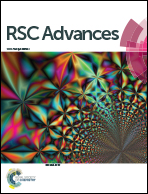Hybridization of PDMS based cyanate ester and DGEBA for radiation resistant and microelectronics applications
Abstract
Cyanate ester terminated polydimethylsiloxane (PDMS-OCN) was synthesized and is copolymerized with DGEBA (1 : 1 and 2 : 1 ratios) through the formation of oxazoline ring to obtain a thermally stable and flexible hybrid PDMS–DGEBA polymer matrix. Subsequently, the radiation resistant behavior of PDMS–DGEBA is studied by a UV treatment process. UV irradiated PDMS–DGEBA films possess an excellent radiation resistance due to the formation of a passive silica layer on the surface of the sample, which effectively protects the materials from UV rays. The silica layer formation was confirmed by scanning electron microscopy (SEM) images. Moreover, X-ray photoelectron spectroscopy (XPS) analysis of PDMS–DGEBA also supports the increasing percentage of silica content after the irradiation of UV rays. Furthermore, the lower values of dielectric constant and dielectric loss, higher thermal stability and excellent radiation resistant properties of PDMS–DGEBA confirm that it can be used as an effective interlayer for low k dielectrics as an insulating material in ultra large scale integrated circuitry (ULSIC) devices.


 Please wait while we load your content...
Please wait while we load your content...